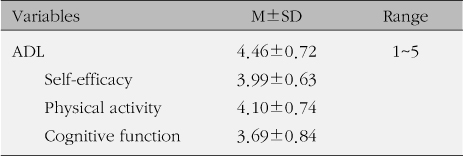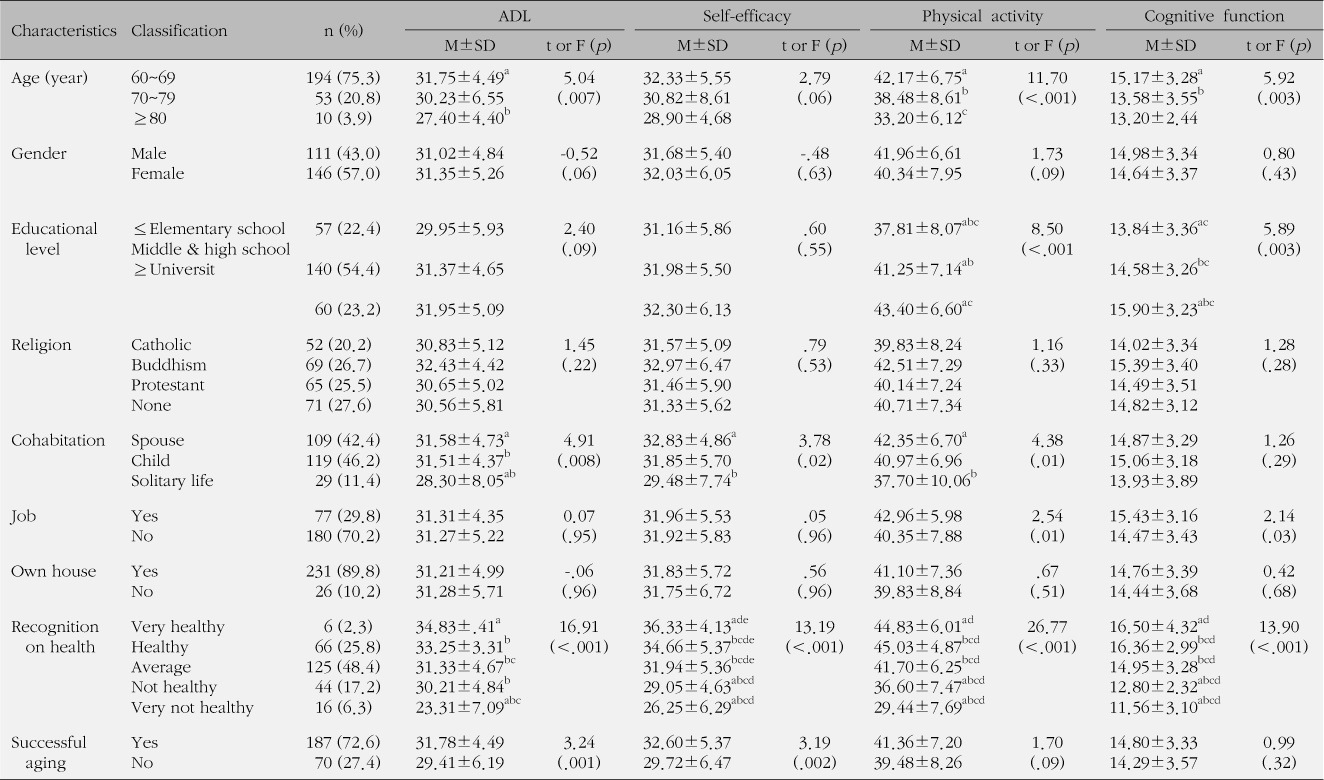References
1. Cho BE. Intergenerational family solidarity and life satisfaction among Korean aged parents. J Korea Gerontol Soc 1990;10(1):105–124.
2. Choi JH, Kim HJ, Lee GM, Kim KS. The effect of sports participation on the status of physical health and depression in the aged. J Phys Educ Lifetime Sport Sci 1999;11:63–77.
3. Chun JW, Park MS. A test of causal model for motivation for job performance, job satisfaction and psychological well-being of the elderly. J Korean Gerontol Soc 2006;26(3):521–545.
4. Crosnoe R, Elder GH. Successful adaptation in the later years. Soc Psychol Q 2002;65(4):309–328.
5. Jang HS. SOC strategies and life-satisfaction in middle and later adulthood. Korean J Psychol Gen 2007;20(2):131–144.
6. Jung HY. A comparative study of factors influencing the life satisfaction of the vulnerable aged group Daejeon: Mokwon University; 2002. Unpublished master's thesis.
7. Kim CG, Jang HJ, Kim SS. The correlation between ability of activity in daily living and self-care agency among elderly in Chunchon province. J Korean Acad Adult Nurs 2001;13(1):40–52.
8. Kim IK, Kim DB, Mo SH, Park KS, Lee YS, Cho SN. Life of Korean elderly: Diagnosis and prospect Seoul: Future Manpower Study Center; 1999.
9. Kim JE. A study on the mental health and regular exercise of the aged: based on the secondary data of '2007 Korea national health and nutrition survey Seoul: Urban Science University; 2009. Unpublished master's thesis.
10. Kim JH, Jung YM. A study on the health age, activity daily of living and cognitive function of the elderly. J Korean Gerontol Nurs 2001;13(1):22–31.
11. Kim MH, Shin KR. The study of the development of the successful aging scale for Korean elderly. J Korea Gerontol Soc 2005;25(2):35–52.
12. Kim TH. Cross-cultural study on family solidarity, filial piety and depression among the elderly. J Korea Gerontol Soc 1999;19(2):79–96.
13. Kim UJ. A comparative study on daily life activity and life satisfaction between the elderly at an institution and those at home: Focused on Chungcheongbuk-Do Chongju: Chongju University; 2001. Unpublished master's thesis.
14. Kwak MS. A study of factors influencing successful aging Seoul: Korean Baptist Theological University; 2004. Unpublished master's thesis.
15. Lee GO. A structural analysis of successful aging factors of rural elders Seoul: Seoul National University; 2007. Unpublished doctoral dissertation.
16. Lee MR. Study of health promoting lifestyle of collegestudents. J Nurs Acad Soc 1997;27(1):156–168.
17. Min KJ. A study on the effect of the daily activities on the quality of life for the aged Seoul: Hansung University; 2006. Unpublished doctoral dissertation.
18. Oh KH. A study on older people's activities of daily living and their life satisfaction. -focused on availability degree of senior welfare center- Chongju: Chongju University; 2002. Unpublished master's thesis.
19. Park EH, Kim SK, Lee HG, Seo YS, Kim DH, Shin DH, et al. Cognitive function, family function and depression in rural elderly. J Korean Acad Fam Med 1997;18(8):814–823.
20. Park MH, Ko JK, Kim ES, Kim HJ, Paik JS, Yang HJ, et al. Geriatric Nursing Seoul: Jungdam Media Pub; 2004.
21. Pender NJ, Walker SN, Sechrist KR, Frank-Stromborg M. Predicting health-promoting lifestyle in the workplace. Nurs Res 1990;39(6):326–332.
22. Rowe JW, Kahn RL. Successful aging New York: Pantheon/Random House; 1998.
23. Selkoe DJ. Normal and abnormal biology of the beta-amyloid precursor protein. Annu Rev Neurosci 1994;17:489–517.
24. Stockert PA. The determination of a health-promoting lifestyle in older adults Unites States: Saint Louis University; 2001. Unpublished doctoral dissertation.
25. Strawbridge WJ, Wallhagen MI, Cohen RD. Successful aging and well-being: Self-rated compared with Rowe and Kahn. Gerontologist 2002;42(6):727–733.
26. Sung HY, Cho HS. A study of successful aging model: Using the components of Rowe & Kahn. J Korean Gerontol Soc 2005;26(1):105–123.
27. William JS, Margaret IW, Richard DC. Successful aging and well-being: self-rated compaired with Rowe and Khan. Gerontologist 2002;42(6):727–733.
28. Won YH. Current status and activation plan of church welfare programs for the aged. J Korean Soc Welf Adm 2003;5:143–166.



